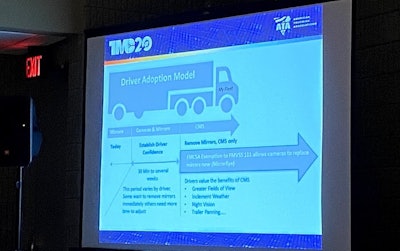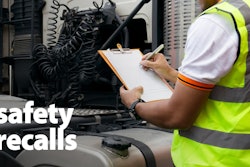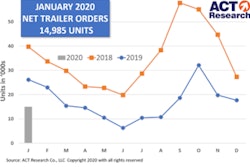 TMC Task Force Chairman Stephen Fox with Stoneridge presenting during Monday’s meeting in Atlanta.
TMC Task Force Chairman Stephen Fox with Stoneridge presenting during Monday’s meeting in Atlanta.The S.4 Cab & Controls study group of ATA’s Technology & Maintenance Council (TMC) has begun development of an engineering recommended practice (RP) for the conversion of rear view mirrors to camera monitoring systems in the trucking industry.
Officially approved by the Federal Motor Carrier Safety Administration (FMCSA) last January, camera monitoring systems (CMS) are promoted in the marketplace as an enhancement and improvement over conventional rear view mirrors — offering drivers increased rear visibility to improve overall vehicle safety. Stoneridge’s Stephen Fox, vice president, business development, is chairing the task force developing the RP.
During a meeting Monday at TMC’s Annual Meeting in Atlanta, Fox showed attendees an early outline of his team’s proposed RP and the topics found within. Because CMS are so new to the trucking industry, Fox said it is important for TMC to create a comprehensive RP now when adoption rates are low so as more fleets show interest in the technology guidance will exist to help them integrate the systems into their operations. Though designed primarily for fleets to aid in their adoption of the technology, the proposed RP also includes valuable information that could be leveraged by truck dealers during new truck spec’ing conversations or parts distributors to initiate retrofitting discussions.

“We’ve found the transition for drivers from learned skills with mirrors to using a CMS is fairly quick, but it does require learning new skills,” he said. “We recommend [drivers] drive with both mirrors and a CMS until they have confidence that the technology does what it is intended to do.”
One topic that was not addressed during Monday’s proposed RP evaluation was return on investment (ROI) calculations for CMS technologies. Fox noted that camera systems offer safety and fuel economy benefits over conventional mirrors — the latter coming from the increased aerodynamics of a truck without side mirrors — but did not provide any payback calculations.
Fleets considering the technology (or dealers hoping to sell it) would need to work directly with their supplier partners to understand the trucks and duty cycles where cameras would likely make sense.











